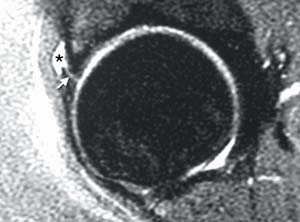Hip arthroscopy effective for young athletes
The procedure bodes well for high-level athletes with enduring symptoms, but not everyone needs it.
Click Here to Manage Email Alerts
![ESSKA [logo]](/~/media/images/news/print/orthopedics-today/2004/06_june/esska_150_138_1783.gif) ATHENS — Hip arthroscopy is
a viable treatment option for some athletes with extensive hip pain and can
help them return to competition within a couple of months of treatment.
ATHENS — Hip arthroscopy is
a viable treatment option for some athletes with extensive hip pain and can
help them return to competition within a couple of months of treatment.
Before hip arthroscopy, these athletes were often resigned to “living within the constraints of their symptoms, which usually meant giving up their competitive athletic careers,” said J.W. Thomas Byrd, MD, of Nashville Sports Medicine & Orthopaedic Center in Tenn.
The three main pathologies associated with such cases are labral tears, articular damage and ligament rupture. “It’s important to remember that any extraarticular problems vastly outnumber the intraarticular problems in most athletes,” he said.
Labral tears account for about 60% of the pathology seen in the hip. A labral tear can occur from an acute injury, from degeneration or a combination of both, Byrd said.
“We are in the beginning stages of learning about labral repairs. I think most of us are scratching our heads trying to figure out which ones are potentially minimal to repair,” Byrd told attendees at the 11th ESSKA Congress. “Most times if someone presents with a labral tear, my reaction is, ‘What was wrong with that hip to make it tear?’ There’s usually something degenerative at work.”
Approximately 55% of labral lesions are going to have associated articular damage, and usually it is the extent of the articular damage that is “the limiting factor” on the success of the hip arthroscopy procedure, he said.
|
COURTESY OF J.W. THOMAS BYRD |
Byrd cited the case of a high-ranking professional tennis player with labral pathology seen on MRI who benefited from surgery. “We went in arthroscopically and found an isolated comminuted anterior labral tear. We were able to excise the damaged labrum, and the rest of his hip was in pretty good shape. He rested for about a month and he came back to competition very strong,” he said.
Unfortunately, not every case is so simple. Another high-ranking tennis player who came to Byrd’s clinic had clear MRI evidence but some labral pathology.
“When we went in arthroscopically, we found that the labral tear was as expected, but there was also a significant articular loss that was not shown to us [on MRI], which posed a poorer prognosis both as far as the length of time to recover and how complete the recovery was going to be following the procedure,” he said.
Acute articular fragmentation occurs from a direct blow of the greater trochanter, such as after a fall. In a healthy athlete with no cushion of the trochanter and good, solid bone stock, “those forces are delivered straight to the hip joint, which results in a shearing force, especially on the medial side of the femoral head,” he said.
Surgeons should also consider the role of the ligamentum teres. “What we focus on more with athletes are acute, traumatic ruptures of the ligamentum teres. You can rupture this without subluxing or dislocating your hip,” often the result of a twisting injury, he said.
Byrd does not advocate indiscriminate debridement of the ligamentum teres. “You never know for sure whether some of these cases may have some [impact on] the vascularity of the femoral head,” he said.
Byrd and his colleagues treated and prospectively assessed more than 600 hip arthroscopy cases, including 120 cases involving competitive athletes. “From our published data, 93% [of the athletes] showed significant improvement after hip arthroscopy,” he said. The greatest improvement was seen in the first month postop, and improvements continued up to the third month. The improvements remained up to five years postop.
There is no evidence to suggest that early intervention is better. “The downside to early intervention is that you may end up doing an operation that is unnecessary. The downside to waiting is that you prolong their eventual recovery, and that doesn’t sit well with the coaches, agents and owners,” he said.
For more information:
- Byrd JWT. Hip arthroscopy in athletes. Lecture 17. Presented at the 11th ESSKA Congress and 4th World Congress on Sports Trauma. May 5-8, 2004. Athens.

